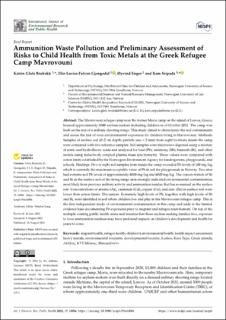| dc.description.abstract | The Mavrovouni refugee camp near the former Moria camp on the island of Lesvos, Greece, housed approximately 3000 asylum-seekers including children as of October 2021. The camp was built on the site of a military shooting range. This study aimed to characterize the soil contaminants and assess the risk of toxic environmental exposures for children living in Mavrovouni. Methods: Samples of surface soil (0–2 cm depth; particle size < 2 mm) from eight locations inside the camp were compared with two reference samples. Soil samples were microwave digested using a mixture of nitric and hydrofluoric acids and analyzed for lead (Pb), antimony (Sb), bismuth (Bi), and other metals using inductively coupled plasma mass spectrometry. These values were compared with action limits established by the Norwegian Environment Agency for kindergartens, playgrounds, and schools. Findings: Five of eight soil samples from inside the camp exceeded Pb levels of 100 mg/kg, which is currently the maximum acceptable value of Pb in soil for playgrounds in Norway. Two sites had extreme soil Pb levels of approximately 8000 mg/kg and 6000 mg/kg. The concen-tration of Sb and Bi in the surface soil of the firing range area strongly indicated environmental contamination, most likely from previous military activity and ammunition residue that has re-mained on the surface soil. Concentrations of arsenic (As), cadmium (Cd), copper (Cu), and zinc (Zn) in surface soil were lower than action limits. Discussion: Extremely high levels of Pb, together with high levels of Sb and Bi, were identified in soil where children live and play in the Mavrovouni refugee camp. This is the first independent study of environmental contamination at this camp and adds to the limited evidence base documenting Pb exposures prior to migrant and refugee reset-tlement. On top of the multiple existing public health crises and traumas that these asylum-seeking families face, exposure to toxic ammunition residues may have profound impacts on children’s development and health for years to come. | en_US |

